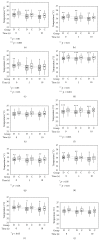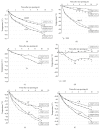Static and Dynamic Measurement of Ocular Surface Temperature in Dry Eyes
- PMID: 27433352
- PMCID: PMC4940548
- DOI: 10.1155/2016/7285132
Static and Dynamic Measurement of Ocular Surface Temperature in Dry Eyes
Abstract
Purpose. To study ocular surface temperature (OST) in dry eyes by static and dynamic measures. Methods. OST was recorded on 62 dry eyes and 63 age- and sex-matched controls. Static measures were study of absolute OST at t = 0, 5, and 10 s after eye opening. Dynamic measures were study of mean change and net change in OST over 10 s of sustained eye opening. Ten OST indices studied were temperatures of the geometric center of the cornea (GCC), extreme temporal (T1) and nasal conjunctiva (T4), midtemporal (CT) and nasal conjunctiva (CN), temporal (LT) and nasal (LN) limbus, and mean (MOST), maximum (Max T), and minimum (Min T) temperatures of the region of interest. Results. For static measures, dry eyes recorded significantly lower GCC, MOST, Min T, Max T, T4, CT, LT, LN, and CN. For dynamic measures, dry eyes had significantly steeper regression line of mean change (corresponding to greater net change) for Max T 5 s onward and T4 at 3 s onward. Conclusions. Both static and dynamic measures of the OST were valuable and can be used as clinical tool to assess dry eye.
Figures



Similar articles
-
Screening Evaporative Dry Eyes Severity Using an Infrared Image.J Ophthalmol. 2021 Aug 24;2021:8396503. doi: 10.1155/2021/8396503. eCollection 2021. J Ophthalmol. 2021. PMID: 34484814 Free PMC article.
-
Temperatures of the Ocular Surface, Lid, and Periorbital Regions of Sjögren's, Evaporative, and Aqueous-Deficient Dry Eyes Relative to Normals.Ocul Surf. 2016 Jan;14(1):64-73. doi: 10.1016/j.jtos.2015.09.001. Epub 2015 Oct 23. Ocul Surf. 2016. PMID: 26505667
-
Accuracy and sensitivity of the dynamic ocular thermography and inter-subjects ocular surface temperature (OST) in Chinese young adults.Cont Lens Anterior Eye. 2009 Apr;32(2):78-83. doi: 10.1016/j.clae.2008.09.003. Epub 2009 Feb 6. Cont Lens Anterior Eye. 2009. PMID: 19200773
-
Ocular surface temperature in patients with evaporative and aqueous-deficient dry eyes: a thermographic approach.Physiol Meas. 2017 Jul 26;38(8):1503-1512. doi: 10.1088/1361-6579/aa78bd. Physiol Meas. 2017. PMID: 28604356
-
Repeatability of infrared ocular thermography in assessing healthy and dry eyes.Cont Lens Anterior Eye. 2016 Aug;39(4):284-92. doi: 10.1016/j.clae.2016.01.010. Epub 2016 Feb 13. Cont Lens Anterior Eye. 2016. PMID: 26883768
Cited by
-
Contact lenses for continuous corneal temperature monitoring.RSC Adv. 2019 Apr 11;9(20):11433-11442. doi: 10.1039/c9ra00601j. eCollection 2019 Apr 9. RSC Adv. 2019. PMID: 35520262 Free PMC article.
-
Effects of motion and b-value on apparent temperature measurement by diffusion-based thermometry MRI: eye vitreous study.Med Phys. 2020 Oct;47(10):5006-5019. doi: 10.1002/mp.14435. Epub 2020 Sep 2. Med Phys. 2020. PMID: 32757301 Free PMC article.
-
Mechanisms, imaging and structure of tear film breakup.Ocul Surf. 2018 Jan;16(1):4-30. doi: 10.1016/j.jtos.2017.09.007. Epub 2017 Sep 20. Ocul Surf. 2018. PMID: 28935579 Free PMC article. Review.
-
The Association between Tear Film Thickness as Measured with OCT and Symptoms and Signs of Dry Eye Disease: A Pooled Analysis of 6 Clinical Trials.J Clin Med. 2020 Nov 23;9(11):3791. doi: 10.3390/jcm9113791. J Clin Med. 2020. PMID: 33238652 Free PMC article.
-
Applications of Infrared Thermography in Ophthalmology.Life (Basel). 2023 Mar 8;13(3):723. doi: 10.3390/life13030723. Life (Basel). 2023. PMID: 36983878 Free PMC article. Review.
References
LinkOut - more resources
Full Text Sources
Other Literature Sources

